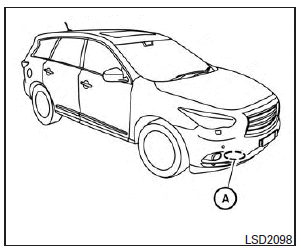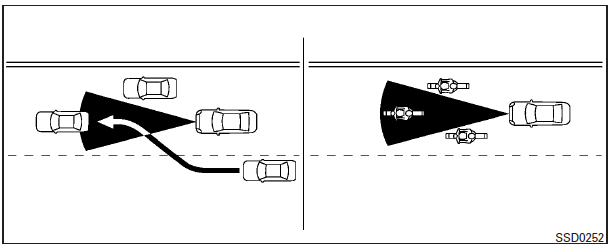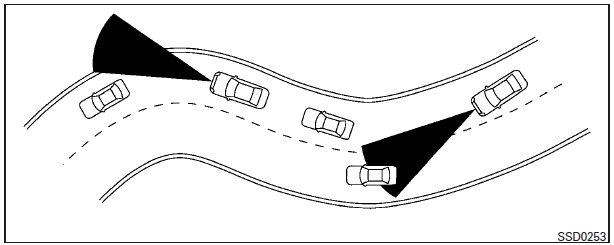Distance control assist operation


Always pay attention to the operation of the vehicle and be ready to manually decelerate to maintain the proper following distance. The Distance Control Assist (DCA) system may not be able to decelerate the vehicle under some circumstances.
The DCA system uses a sensor A located behind the front bumper of the vehicle to detect vehicles traveling ahead. The sensor generally detects the signals returned from the vehicle ahead. Therefore, if the sensor cannot detect the reflection from the vehicle ahead, the DCA system may not operate.
The following are some conditions in which the sensor cannot detect the signals:
● When snow or road spray from traveling vehicles reduces the sensor’s visibility
● When excessively heavy baggage is loaded in the rear seat or the luggage room of your vehicle
The DCA system is designed to automatically check the sensor’s operation. When the front bumper area of the distance sensor is covered with dirt or is obstructed, the system will automatically cancel. If the front bumper area of the distance sensor is covered with ice, a transparent or translucent vinyl bag, etc., the DCA system may not detect them. In these instances, the vehicle-tovehicle distance control mode may not cancel and may not be able to maintain the selected following distance from the vehicle ahead.
Be sure to check and clean the front bumper area of the distance sensor regularly.
The DCA system is designed to help assist the driver to maintain a following distance from the vehicle ahead. The system will decelerate as necessary and if the vehicle ahead comes to a stop, the vehicle decelerates to a standstill. However, the DCA system can only apply up to 25% of the vehicles total braking power. If a vehicle moves into the traveling lane ahead or if a vehicle traveling ahead rapidly decelerates, the distance between vehicles may become closer because the DCA system cannot decelerate the vehicle quickly enough. If this occurs, the DCA system will sound a warning chime and blink the system display to notify the driver to take necessary action.
See “Approach warning” in this section.
This system only brakes and moves the accelerator pedal upward to help assist the driver to maintain a following distance from the vehicle ahead. Acceleration should be operated by the driver.
The DCA system does not control vehicle speed or warn you when you approach stationary and slow moving vehicles. You must pay attention to vehicle operation to maintain proper distance from vehicles ahead.

The detection zone of the sensor is limited. A vehicle ahead must be in the detection zone for the system to operate.
A vehicle ahead may move outside of the detection zone due to its position within the same lane of travel. Motorcycles may not be detected in the same lane ahead if they are traveling offset from the centerline of the lane. A vehicle that is entering the lane ahead may not be detected until the vehicle has completely moved into the lane. If this occurs, the system may warn you by blinking the system indicator and sounding the chime. The driver may have to manually control the proper distance away from vehicle traveling ahead.

When driving on some roads, such as winding, hilly, curved, narrow roads, or roads which are under construction, the sensor may detect vehicles in a different lane, or may temporarily not detect a vehicle traveling ahead. This may cause the system to work inappropriately.
The detection of vehicles may also be affected by vehicle operation (steering maneuver or traveling position in the lane, etc.) or vehicle condition. If this occurs, the system may warn you by blinking the system indicator and sounding the chime unexpectedly. You will have to manually control the proper distance away from the vehicle traveling ahead.
See also:
Cleaning exterior
In order to maintain the appearance of
your vehicle, it is important to take proper
care of it.
To protect the paint surface, wash your
vehicle as soon as you can:
► after a rainfall t ...
Exhaust gas (carbon monoxide)
WARNING
• Do not breathe exhaust gases; they contain colorless and odorless carbon monoxide. Carbon monoxide is dangerous.It can cause unconsciousness or death.• If you suspect that exhaust fumes are ...
Overview
The Infiniti G37 Coupé offers dramatic performance in a thoroughly seductive
shape. Although sharing a great deal of hardware with the Infiniti G37 Sedan,
the Coupé is designed to ap ...
